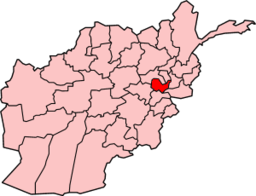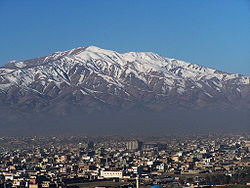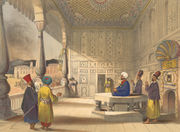Kabul Province
| Kabul (کابل) | |
| Province | |
| Country | |
|---|---|
| Capital | Kabul |
| - coordinates | |
| Area | 4,462 km² (1,723 sq mi) |
| Population | 3,568,500 (2009) [1] |
| Density | 763 / km² (1,976 / sq mi) |
| Governor | Haji Din Mohammad |
| Timezone | UTC+4:30 |
| Main languages | Pashto Dari Persian |
 Map of Afghanistan with Kabul highlighted
|
|
Kābul (Pashto/Persian: کابل - Kābəl), situated in the east of the country, is one of the thirty-four provinces of Afghanistan. The capital of the province is Kabul City, which is also Afghanistan's capital. The population of Kabul province is 3.5 million people as of 2009,[1] of which almost 80 percent live in the urban areas.[2] The current governor of the province is Dr. Zabihullah Mojaddidy.
Contents |
Geography

Kabul is located between Latitude 34-31' North and Longitude 69-12' East at an altitude of 1800 m (6000 feet) above sea level, which makes it one of the world's highest capital cities. Kabul is strategically situated in a valley surrounded by high mountains at crossroads of north-south and east-west trade routes. One million years ago the Kabul region was surrounded from south-east between Lowgar and Paghman Mountains; Charikar in the north and the Ningai Ghar mountains in the west. This region formed an icy sea. In the Silurian time, at the end of ice era, the icebergs are melted gradually and the territory of this region was poured by water under heavy raining. Some deep wells in the region of today's Poli Charkhi in the east part of city are the evidence of that time. Kabul is surrounded by Koh-e Paghman Mountain from the east, Koh-e Qrough Mountain from the south-west and Koh-e Shirdarwaza Mountain from the north-east. Kabul has only one river which is called Kabul River. Kabul River rises at the Paghman Mountain toward South Pass about 70 km (45 miles) west of Kabul. It flows in an easterly direction, past Kabul, and through Jalalabad city, and then on to Dakka where it enters Pakistani territory and finally runs into the Indus at Attock.
The climate within region of Kabul is considered to be arid to semi-arid steppe. Because of the very low amounts of precipitation, especially from May to November, Kabul can be very dry and dusty. Extreme temperature changes occur from night to day, season to season, and from place to place. The chief characteristic of Afghanistan's climate is a blue cloudless sky with over 300 days of sunshine yearly. Even during the winter, skies usually remain clear between snowfalls, which are on average 15 to 30 cm annually. The daily temperature in winter is -15 to -20 degrees Celsius (°C), and in summer +15 to +30°C. The coldest month of the year is January when the average temperature is -12°C, and the hottest month is July when the average is 25°C. The maximum temperature has been recorded as +42.7°C in July and the minimum as -26.3°C in January.
History

Kabul's history dates back more than 3,000 years. It was once the center of Zoroastrianism [3] and subsequently also a home for Buddhists and Hindus. The Arabs conquered the area in the 7th century but was slowly taken back by the Hindu Shahi's of Kabul. It was then conquered by Mahmud of Ghazni in 1002, when the Hindu Shahi King Jay Pala committed suicide.
For much of its time Kabul was independent until it became part of the Durrani Empire in 1700s. During the First Anglo-Afghan War in 1839, the British army took over Kabul. In 1842, the withdrawing British troops were ambushed and almost annihilated after the Afghans had promised them safe conduct; in retaliation another British force partly burned Kabul. The British again occupied the city in 1879, after their resident staff were massacred there. On December 23, 1979, Soviet armed forces landed at Kabul International Airport to help bolster a Communist government.
Kabul became the Soviet command center for approximately 10 years during their stay in Afghanistan. In February 1989, Soviet forces withdrew from the city after they were defeated by the Afghan Mujahideens. In spring of 1992 the government of Mohammad Najibullah collapsed, Kabul fell into the hands of Mujahideen forces. Destruction of the city increased as the coalition of the parties broke into rival warring factions, and much of Kabul was damaged. In 1996 the Taliban took over the city and started a new strict Islamic Sharia law which included Islamic schools, government, clothing, food, and recruitment to Al Qaeda, impacting the Afghan people's daily life. Some people happier with the strict Islamic laws, while some were unhappy.
On November 12, 2001, American military forces finally took over Kabul, the Taliban forces fled by then. The Karzai administration that is led by Hamid Karzai was established in Kabul, and re-construction of new buildings, schools, and universities slowly began in 2002.
Politics
Kabul has been long known for its politics and different warlords. It was under the control of many political groups and warlords when Mohammad Najibullah's government collapsed. Kabul city was in the hands of many political groups who fought for power until it was taken over by the Taliban in 1996 and its politics was changed. Kabul's politics become more aligned with the Islamic regime and new laws were introduced by the Taliban. There was only one leader for Afghanistan Mullah Omar, the head of Taliban who ran Kabul's political party until the US invaded on October 7, 2001. New laws and humanities came in effect to enable Kabul to recover from the destruction caused by the Taliban. Loya Jirga took place to solve the current political problems and situations in Kabul and introduce new laws. Kabul citizens have been given the right to vote.

After being re-scheduled twice, Afghanistan's presidential elections were held on October 9, 2004. Over 8 million Afghans voted in the elections. The Joint Electoral Management Body of Afghanistan certified the elections on November 3, and declared Hamid Karzai, the interim President, the winner with 55.4% of the vote. Karzai's strongest opponent, Yunus Qanuni, received 16.3% of the vote. The elections were not without controversy; allegations of fraud and ballot stuffing were brought up by many of the presidential candidates including Yunus Qanuni. Many felt that Hamid Karzai had an unfair advantage over the other candidates as he had access to financial and logistical resources that many of the other candidates did not have. A panel of international experts was set up to investigate the matter. The panel did find evidence of voting irregularities, however, they said that it was not enough to affect the outcome of the elections. Some people claimed that they were forced to vote for the current president and some claim that they were paid to do so.
With help from the United States and the United Nations, Afghanistan adopted its new constitution, establishing the country as an Islamic Republic, in early January 2004. According to the constitution, the Afghan government consists of a powerful and popularly elected President, two Vice Presidents, and a National Assembly consisting of two houses: the House of People (Wolesi Jirga), and the House of Elders (Meshrano Jirga). There is also an independent Judiciary branch consisting of the Supreme Court (Stara Mahkama), High Courts and Appeal Courts. The President appoints the members of the Supreme Court with the approval of the Wolesi Jirga. Assembly elections were planned for late 2005.
Economy
Most of Kabul's economy depended on its tourists in the 1960s and 1970s. Kabul had textile, cotton production, and carpet production industries, but most of its economy came through tourism which it lost during its destruction. Kabul's products include: natural gas, cotton, wool, carpets, agriculture, and some small production companies. Kabul has trade partnerships with the UK, France, Germany, USA, India, South Korea, Turkmenistan, Kenya, Russia, Pakistan, China, Iran. Kabul's economy was influenced by the American power and has increased by almost 3500% after being down for 25 years. A new currency was introduced to Afghans which helped the economy. New business was in the new regime. Many American industries were interested in the new Kabul and many new companies have since then opened their branches in Kabul. The Kabul City Centre Mall was built and has nearly 100 shops. [4] The economy is at a boom level and is increasing dramatically. Housing costs are rising as are employee wages. The cost of living has increased dramatically which is a problem for the non-educated Afghans, who cannot support themselves. The UN helps Afghans in need of help by providing aid, food and school materials for schools. Many international aid organizations are contributing to the Afghan economy.
Demographics and administration

The population of Kabul province is 3.5 million people,[1] of which about 80 percent live in the urban areas (mainly in the Kabul metropolitan area) while the remaining 20 percent are rural residents.[2]
The Afghan Ministry of Rural Rehabilitation & Development along with the United Nations High Commissioner for Refugees (UNHCR) estimate that Pashtuns are approximately 60% of the population and make up the majority in the province, followed by Persian-speaking Tajiks and Hazaras who are the majority in Kabul City. Overall, Persian speakers are estimated to be around 40% of the population[2], and many Pashtuns in Kabul also speak Persian instead of their native Pashto language. Uzbeks, Turkmens, Balochs, Sikhs and Hindus, who are found mainly in the capital city, form sizable minorities.
About 85% of the population is Sunnite while 14% include Shi'ites. The remaining 1% are followers of Sikhism, Hinduism and other religions. The major Pashtun tribes in the province are the Ghilzai, Shinwari, Khugyani, Wardak and Safi.[3]
Districts
| District | Capital | Population | Area[4] | Ethnical data(%) [5] | Notes |
|---|---|---|---|---|---|
| Bagrami | Bagrami | 85,000 | 70% Pashtuns, 30% Tajiks [6] | ||
| Chahar Asyab | Qalai Naeem | 32,500 | Pashtuns, Tajik and Hazara [7] | ||
| Deh Sabz | Tarakhel | 47,900 | 70% Pashtuns, 30% Tajiks [8] | ||
| Farza | Dehnawe Farza | 19,100 | mixture of Pashtuns and Tajiks [9] | Created in 2005 within Mir Bacha Kot District | |
| Guldara | Guldara | 20,300 | 50% Pashtuns, 50% Tajiks [10] | ||
| Istalif | Istalif | 29,800 | 90% Tajiks, 10% Pashtuns and Hazara[11] | ||
| Kabul | Kabul (capital) | 1,925,548[2] | 45% Tajiks, 25% Hazara, 25% Pashtun, 2% Uzbek, 1% Balochi, 1% Turkmen, 1% others[12] | ||
| Kalakan | Kalakan | 26,900 | 90% Tajiks, 10% Pashtuns [13] | ||
| Khaki Jabbar | Khak-i Jabbar | 75,000 | 95% Pashtuns, 5% Tajiks [14] | ||
| Mir Bacha Kot | Mir Bacha Kot | 46,300 | 90% Tajiks, 10% Pashtuns [15] | Sub-divided in 2005 | |
| Mussahi | Mussahi | 30,000 | 60% Pashtuns,40% Tajiks [16] | ||
| Paghman | Paghman | 150,000 | 70% Pashtuns, 30% Tajiks [17] | ||
| Qarabagh | Qara Bagh | 67,700 | 60% Tajiks, 40% Pashtuns [18] | ||
| Shakardara | Shakar Dara | 72,900 | Tajik Majority [19] | ||
| Surobi | Surobi | 150,000 | 90% Pashtuns, and the rest are Pashais [20] |
Transportation

Transportation in Kabul is improving as the numbers of new vehicles and experienced drivers are increasing. There is public transportation service in the Kabul vicinity, but many roads are in disrepair. Drivers are also impeded by the large number of cyclists. More vehicles are seen in the city because people are purchasing cars. Taxi cabs are found everywhere in the city, also in most of the districts of Kabul.
Kabul's Milli Bus (National Bus) system, which has about 800 buses, provides service to the city and nearby areas. There are several new highways in the province, and the government has scheduled to rebuild most of the smaller roads. Funding for the roads comes from current drivers who must pay toll charges for driving on highways and major roads. The money is collected by the government through issuing motorists monthly, quarterly or annual inspection certificates that are affixed to the windshield of their vehicles.
Trucks are used to transport goods from one district to another, or to other cities of the country. The Afghan government, with the help of foreign companies or organizations, have begun work on many of Kabul's roads. Auto companies like Honda, Toyota, Ford Motor Company, and Chevrolet have also been reintroduced in Kabul.
Education
Kabul is Afghanistan's center for education. People from all the provinces of the country come to Kabul for education. There are many schools and universities that have opened doors for men and women. In the 1970s, about 55% of Kabul's population was educated without materials or proper learning resources to get a proper education. Most of the young children are sent to work by their parents to support their living costs. The education rate has declined dramatically during the last 20 years. Most of the schools in Kabul were set as battle points during the wars and have been demolished.

List of Universities in Kabul
- American University of Afghanistan
- Kabul University
- Polytechnical University of Kabul
- National Military Academy of Afghanistan
- Kabul Medical University
- Kardan University
- Bakhtar University
- Dawat University
- Karwan University
- Rana Institute of Higher Education
- Maryam University
List of schools in Kabul
- Habibia High School (British-Afghan school founded in 1904 as Habibya College)
- Amani High School (German-Afghan school for boys founded in 1924)
- Ghulam Haider Khan High School
- International School of Kabul.[21][22][23]
- Lycée Esteqlal and Lycée Malalaï (French lycées founded in 1922 and 1932 respectively)
- Aisha-i-Durani School (or Mädchengymnasium Aysha-e Durani) and Wirtschaftsgymnasium für Mädchen Jamhuriat (German-Afghan schools for girls)
- Sultana Razia School
Sports

Kabul is the center of annual buzkashi and football tournaments, where teams from all over Afghanistan, Pakistan, Iran, Uzbekistan, and Tajikistan participate. Sports is a daily routine for employees in Afghanistan, when they all join each other in tournaments and matches, specially soccer games. Afghanistan's Soccer Team also participated in many Asian Soccer Leagues. Many Afghans who were living as refugees in Pakistan and India returned back to their country, and they brought the game of cricket with them. Afghanistan now has national Cricket Team that plays internationally. They play mostly against Pakistani and Hindi Teams as well as some Arab nations in the Middle East. The Province is represented in Afghan domestic cricket by the Kabul Province cricket team, who were the inaugural winners of the 2010 Etisalat 50 over tournament.
There are Boxing, Taekwondo, Volleyball, and Kung fu teams in Kabul, which participate in tournaments locally and go on tours to other Asian countries. One of the oldest and most popular stadiums in Kabul is Ghazi Stadium, where tournaments, concerts, and national celebrations take place, however the city has lost most of the stadiums it previously had. Ghazi Stadium is currently going through a reconstruction programme whereby a new design and a new system will be established for the stadium. There is also another new stadium under construction near Kabul City. Schools and universities encourage participation in team sports, and there is a group of Afghans are being trained in Kabul for the next Olympic Games.
See also
- Kabulistan
- Kabul Golf Club
References
- ↑ 1.0 1.1 1.2 Central Statistics Office, Afghanistan Statistical Yearbook 2009/10, [1]
- ↑ 2.0 2.1 2.2 2.3 "Kabul Provincial Profile", NABP (National Area-Based Development Programme), Ministry of Rural Rehabilitation and Development, Islamic Republic of Afghanistan, [2]
- ↑ Kabul povince summary, Naval Postgraduate School
- ↑ Afghanistan Geographic & Thematic Layers
- ↑ Ethnic demographic statistics taken from http://www.aims.org.af
- ↑ http://www.aims.org.af/afg/dist_profiles/unhcr_district_profiles/centra/kabul/bagrami.pdf
- ↑ http://www.aims.org.af/afg/dist_profiles/unhcr_district_profiles/centra/kabul/char_asiab.pdf
- ↑ http://www.aims.org.af/afg/dist_profiles/unhcr_district_profiles/centra/kabul/deh_sabz.pdf
- ↑ http://www.aims.org.af/afg/dist_profiles/unhcr_district_profiles/centra/kabul/farza.pdf
- ↑ http://www.aims.org.af/afg/dist_profiles/unhcr_district_profiles/centra/kabul/guldara.pdf
- ↑ http://www.aims.org.af/afg/dist_profiles/unhcr_district_profiles/centra/kabul/District_Profile_istalif_04_04_02.pdf
- ↑ National Geographic Society. Ethnic Groups [map] (PDF).
- ↑ http://www.aims.org.af/afg/dist_profiles/unhcr_district_profiles/centra/kabul/kalakan.pdf
- ↑ http://www.aims.org.af/afg/dist_profiles/unhcr_district_profiles/centra/kabul/khak_e_jabbar.pdf
- ↑ http://www.aims.org.af/afg/dist_profiles/unhcr_district_profiles/centra/kabul/mir_bacha_kote.pdf
- ↑ http://www.aims.org.af/afg/dist_profiles/unhcr_district_profiles/centra/kabul/mussahi.pdf
- ↑ http://www.aims.org.af/afg/dist_profiles/unhcr_district_profiles/centra/kabul/paghmani.pdf
- ↑ http://www.aims.org.af/afg/dist_profiles/unhcr_district_profiles/centra/kabul/qarabagh.pdf
- ↑ http://www.aims.org.af/afg/dist_profiles/unhcr_district_profiles/centra/kabul/shakardara.pdf
- ↑ http://www.aims.org.af/afg/dist_profiles/unhcr_district_profiles/centra/kabul/sarobe.pdf
- ↑ D’Afghanistan, Leylâ (2003). "La genèse du droit de la femme en Afghanistan" (in French). Les Cahiers du Cremoc (Paris: CREMOC (Centre de recherche sur l'Europe et le monde contemporain)) (nr. 36). http://www.cremoc.org/articles/afgfem.pdf. Retrieved 2009-11-06.
- ↑ "Förderverein Amani Oberrealschule Kabul" (in German). F.A.O.K.. http://www.amani-ors-kabul.com. Retrieved 2009-11-06.
- ↑ "Offizielle Homepage der Amani Oberrealschule Kabul" (in German). Kabul: Amani Oberrealschule Kabul. http://amani.get-concept.de/. Retrieved 2009-11-06.
External links
- What's On In Kabul (pdf format)
- Historical Photos of Kabul
- Historical Guide to Afghanistan (Kabul)
- Kabul Caravan
|
|||||||
|
|||||